The risks associated with gas appliances are real
The need for acidic condensate neutralizers.

High-efficiency boilers, furnaces and water heaters can release harmful acidic waste that occurs when return water temperatures reach or drop below 130° F or 135° F. Photos courtesy of Common Ground
Modern condensing, gas-fired heating appliances have saved giant quantities of fuel worldwide, to say nothing of the vast reduction of carbon emissions.
High-efficiency boilers, furnaces and water heaters are admired by home or business owners for their reliability and gentle sipping of fuel. Installers love them, too, especially considering the ability for one guy to easily transport and mount a 200 MBH boiler. Compare that to a team of strapping dudes required to set the one it replaced.
These new, lightweight, super-efficient appliances scrub every ounce of thermal energy — effectively salvaging Btu — from combustion chambers.
Yet, there’s a dark little secret that got buried in the rush to achieve higher operational efficiency: the equipment releases harmful acidic waste. It occurs when return water temperatures reach or drop below 130° F or 135° F.
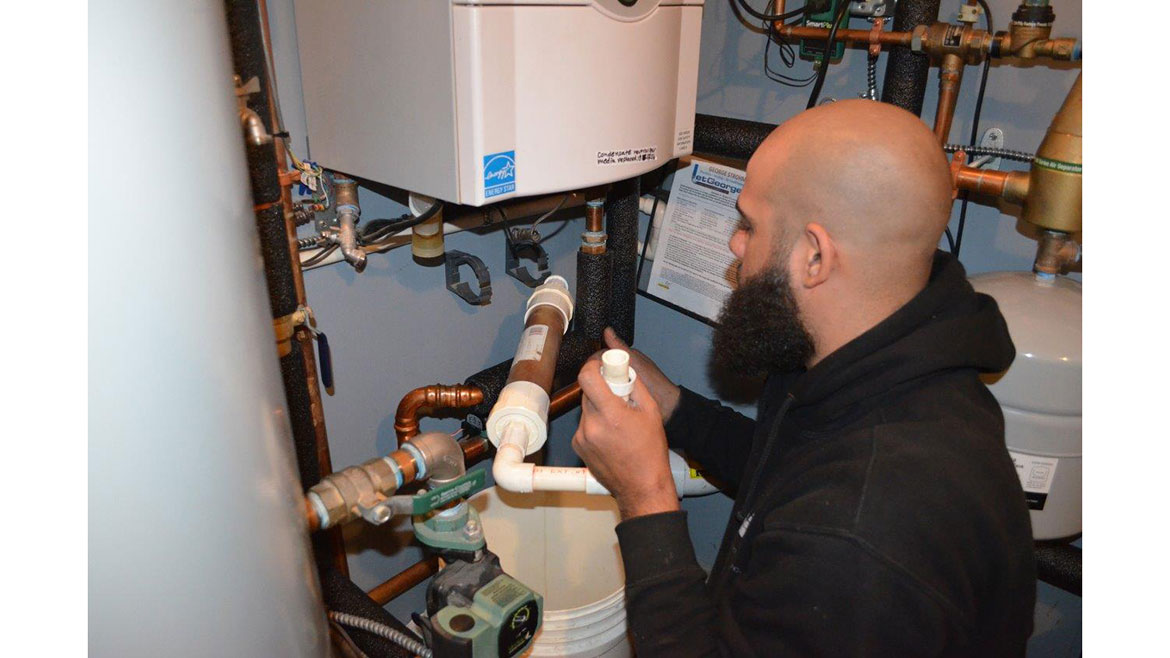
The solution for acidic condensate is really quite simple. All acidic wastewater must first flow from an appliance in non-corrosive piping such as schedule 40 PVC, CPVC or polypropylene on its way into small chunks of calcite (not limestone).
The condensate “sweat” is so corrosive that it can quickly tunnel through steel pipe or reinforced concrete. Cast iron doesn’t stand a chance against it.
This is the gremlin in the works, and it’s way too often ignored.
For a boiler producing heat for low-temp radiant heat distribution, more condensate will be produced. Alternately, high-temp heat production produces less condensate.
The condensate/caustic waste is a result of the combustion process in high-efficiency gas (International Fuel Gas Code Category III + IV) appliances. The higher the AFUE (or “Annual Fuel Utilization Efficiency”) rating, the higher quantity of condensate wastewater runoff.
While this broadly accepted point is generally true, Dave Yates — whose expertise in forensic plumbing and mechanical systems is unparalleled — points out that, with condensing appliances, acid concentrations in condensate, read acidity, is tied to three key variables:
- Chemical makeup and quality of the fuel;
- Proper combustion including a combustion test to manufacturer’s specs; and
- System efficiency — considering both the efficiency of the appliance and the system design
The last of these, system efficiency, is the leading contributor to boiler short-cycling. Even though a boiler may be properly sized and installed and has had its combustion process properly tested and adjusted. If the boiler’s controls aren’t properly set and the system isn’t properly designed, the boiler may short-cycle.
Short cycling rarely allows the heat exchanger to dry out in between cycles. This is the most common cause of higher than normal acidity in condensate from heating appliances.
Yates owned York, Pennsylvania-based F. W. Behler for 35 years, one of the nation’s oldest, continuously-operated plumbing and mechanical firms (established in 1887). He's since become one of most sought-out courtroom experts in the country.
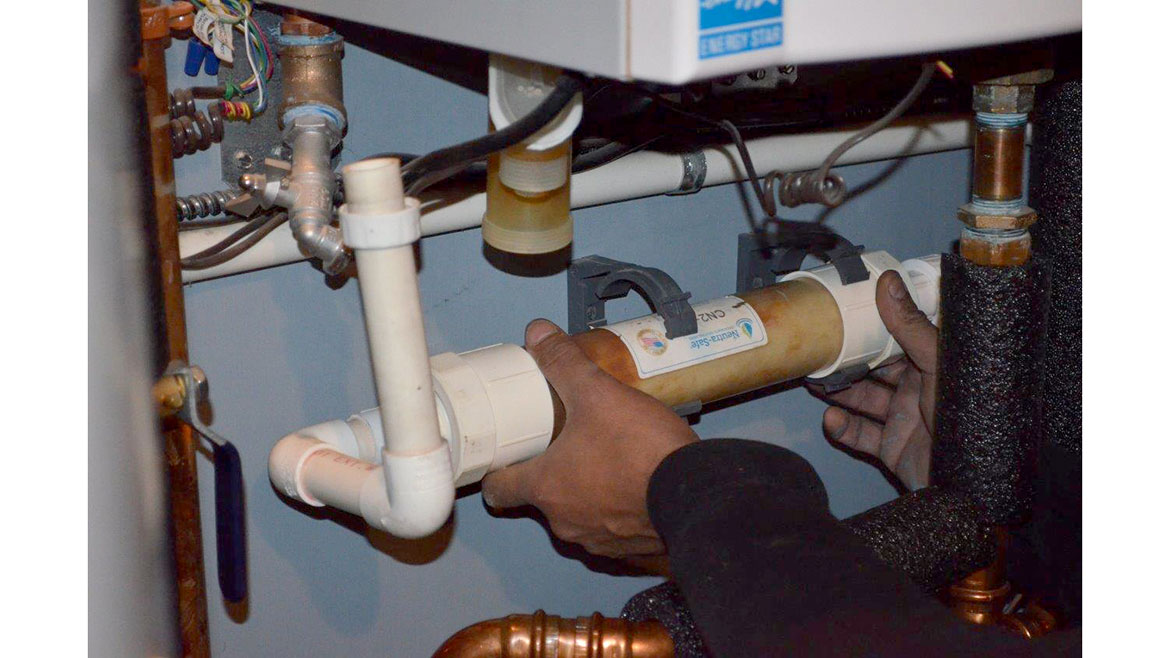
Once installed, a condensate neutralizer’s media must be changed routinely; typical change-out time for calcite media is a year. If ignored, some types of media simply turn to sludge, preventing the escape of acidic waste.
Voilà!
The solution for acidic condensate is really quite simple. All acidic wastewater must first flow from an appliance in non-corrosive piping such as schedule 40 PVC, CPVC or polypropylene on its way into small chunks of calcite (not limestone).
For installers that already follow this recipe: Voilà! The problem is solved.
This near-miraculous chemical reaction happens within a “condensate neutralizer” — essentially a narrow tube filled with calcite gravel. The result is a fully-fixed, deactivated liquid that can be released harmlessly as wastewater.
“The fix for acidic condensate is easy and inexpensive, but it must be attended to,” Yates says. If ignored, Yates warns, acidic condensate is free to literally “melt away” concrete floors and drain pipes, or worse.
If the condensate line terminates above a boiler (furnace or water heater) trap, a condensate pump is required.
Yates suggests a condensate pump with an overflow switch that shuts down the appliance if the pump fails, or if the drain path is blocked or frozen. Some condensate pumps offer neutralization.
Not only is a condensate neutralizer a must for modulating-condensing (“mod-con”) heating systems, but once a neutralizer is added — it, too, must be attended to.
Once installed, a neutralizer’s media must be changed routinely; typical change-out time for calcite media is a year. If ignored, some types of media simply turn to sludge, preventing the escape of acidic waste. If the waste backs up into and deteriorates the combustion chamber or the flue gas chimney, the results can dramatically reduce the life of the heat exchanger.
Acidic etching of metal surfaces in the combustion chamber, or elsewhere within the appliance or venting may also foretell damage to a heat exchanger.
“All gas-fired boilers, water heaters and furnaces experience wetted acidic condensation during a cold-start, but properly installed systems dry out so quickly that the acidic condensate evaporates harmlessly,” Yates adds.
Potentially life-saving
Ultimately, the real goal here is to avoid the formation of acidic concentrate anywhere where it’s not wanted. With high-efficiency condensing systems, it’s wanted and, by design, deliberately encouraged within the combustion chamber. There, the last remaining concentrations of thermal energy are extracted, thus adding to the heating equipment’s efficiency.
It's at this point, however, that manufacturers of these systems want the flow of waste condensate to find its way easily into a neutralizer where its acid can be deactivated.
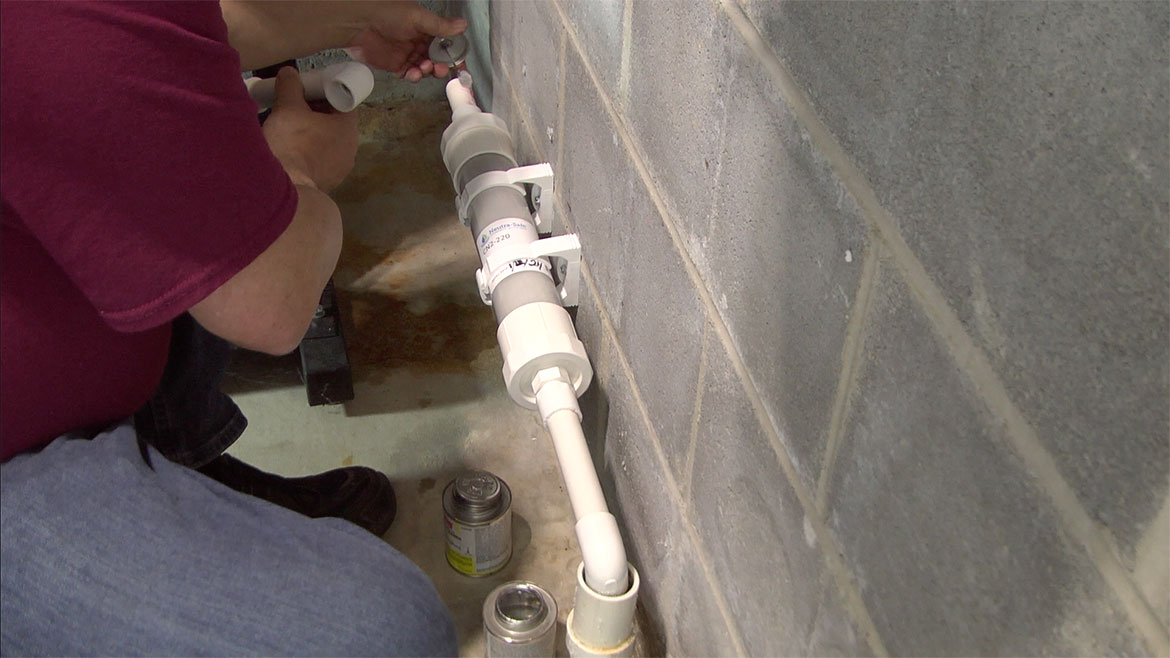
Installing a condensate neutralizer is the only effective way to treat acidic waste.
Acid by the drum
A normal, 2,500 to 3,000 square foot, three or four bedroom home might require a 100,000 Btu hi-efficiency furnace or boiler. The condensing appliance, while sipping small amounts of fuel, may produce up to 2,500 gallons of acidic condensate waste each year — easily enough to damage or destroy waste plumbing or septic systems.
The broadly used calculation is that, for every 100,000 Btu produced by a condensing heating system, up to one gallon of acidic waste is produced each hour. A tankless, condensing water heater produces less acidic waste, but it’s still considerable. “In fact, a 200 MBH water heater, on average, produces eight 55-gallon drums of acidic waste each year,” says Jim Simas.
Simas is president of Randolph, Massachusetts-based Emerson Swan, one of the nation’s largest manufacturers’ representative firms. The company’s experts, serving the plumbing and mechanical market since 1932, know a thing or two about new heating and cooling technology.
“Plumbing codes call for the use of neutralizers,” Simas continues. “The technology prevents the need for costly repairs to floors and plumbing systems among a host of other challenges.”
Cancer-like
Acidic condensate wages war on every surface it sees.
“Ignored, it’s like a malicious, malignant cancer that wreaks havoc in modern heating systems. It can lead to huge problems,” Yates says. “I've seen it first-hand many times. With high efficiency, modulating condensing furnaces and boilers, the steady flow of caustic condensate etches, then carves out concrete floors. It can also eat away a ribbon-like channel of cast iron drainage piping along its bottom, which leads to expensive repairs. That’s quite common.”
By design, condensate neutralizers eliminate the challenge.
These devices — like the Neutrasafe CN2-220 (for use with appliances up to 220,000 Btu/h in size) or the Neutra-Safe NSP-50 neutralizing condensate pump for appliances with up to 500,000 Btu/h input — are built specifically to deal with this problem.
Typically, neutralizer media is sized to last a year. It’s then removed, thrown away and replaced. Thus, we’re reminded of the need for annual maintenance, most often included as part of pre-season service.
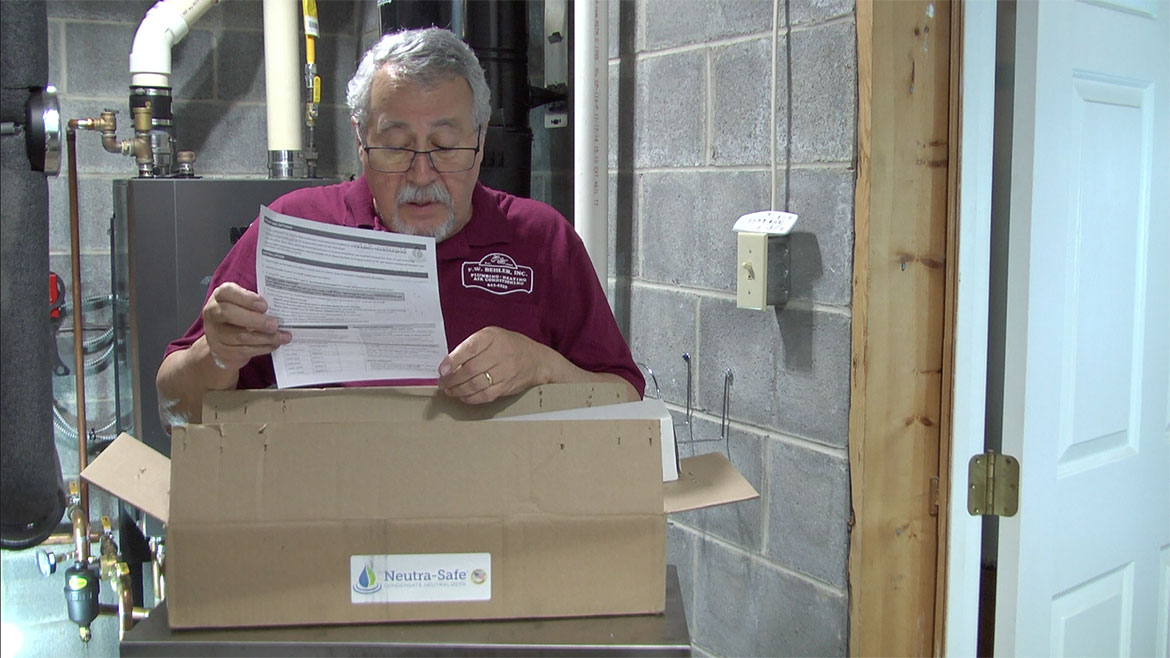
Dave Yates, PM columnist and former owner of F.W. Behlor, reads over the installition instructions for Neutra-Safe.
Environmental risks
If acidic runoff is allowed to drain into residential or commercial plumbing, some pipes will begin to corrode immediately — as will local sewers, water treatment facilities or septic systems.
Pumping the waste outdoors could also contaminate groundwater or degrade local water infrastructure. For homes with septic tanks, condensate waste could also kill the good bacteria, essential to keeping systems operating properly.
The pH of wastewater needs to remain between 6 and 9 to protect the microscopic organisms that are so vital to sewage disposal.
The greater, front-end cost for high-efficiency equipment is usually justified by lower energy consumption and the resulting lower fuel bills. But those savings could easily be thrown away (and then some) if the installer is called back to replace a home’s or business’s plumbing infrastructure. The smarter, long-term solution is to neutralize the acidic waste.
International Plumbing Code (IPC) Section 803.1 and National Standard Plumbing Codes (NSPC) require condensate neutralization for appliances that produce acidic waste, though enforcement is inconsistent.
“Some sections of the country, such as in the New England states, strictly enforce this code requirement,” Simas says. “But in others areas, such as in the Southeast and Southwest, it’s given little attention.”
The codes state that corrosive liquids, spent acids or other harmful chemicals that destroy or injure drain, sewer, soil or waste pipe, create noxious or toxic fumes, or interfere with sewage-treatment processes must not be discharged into plumbing systems without being properly diluted, neutralized, or treated by passing through an approved dilution, filtration or neutralizing device.
Measurement
The pH level of condensate as a byproduct of condensing heat technology can be as low as 1.8 and generally falls somewhere between 1.8 to 4.2 on the pH scale. Any aqueous solution with a pH below 7 is considered corrosive.
“Condensate from my own mod-con boiler recently tested at 5.3-pH before it was treated, and 8.4-pH after treatment,” Yates says. “Once condensate has been neutralized to a safe pH level — pH 5.5 to 9.5 — it’s no longer harmful.
Yates explains that his boiler’s pH was measured using an electronic pH meter that was first calibrated for accuracy. He also tested for TDS (total dissolved solids), and hardness.
“Manufacturers are beginning to require accurate testing before providing heat exchanger warranty replacements,” he adds. “If the hydronic water hasn't been treated and the tests reveal adverse conditions, there’s little or no chance of warranty replacement.”
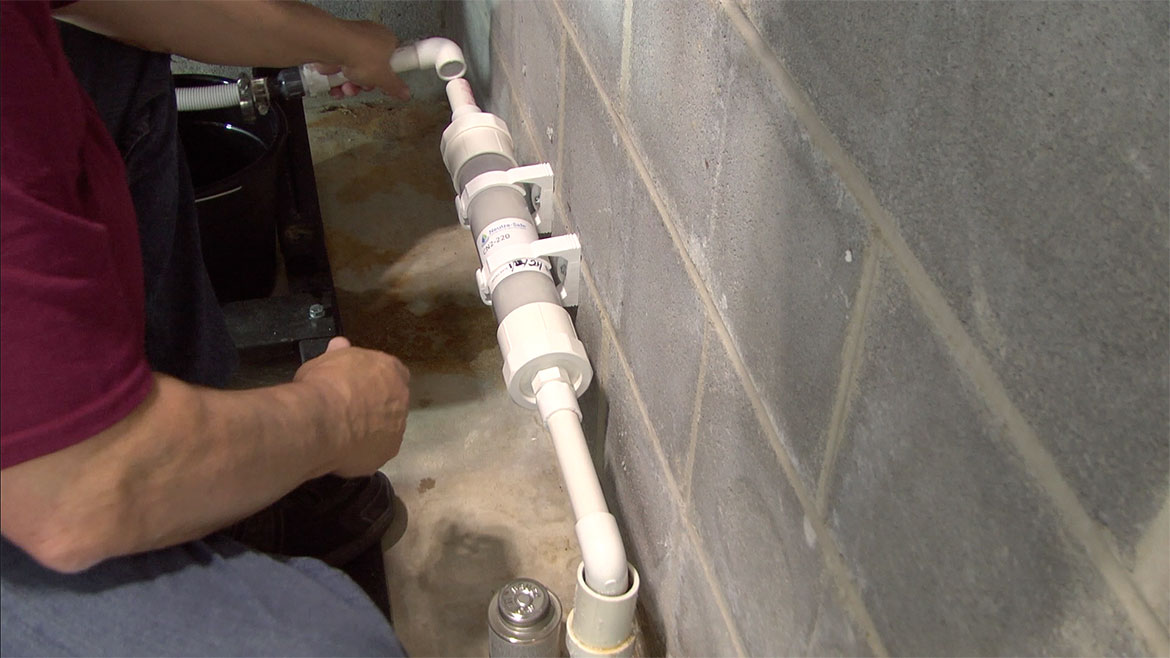
The plumbing codes state that corrosive liquids, spent acids or other harmful chemicals that destroy or injure drain, sewer, soil or waste pipe, create noxious or toxic fumes, or interfere with sewage-treatment processes must not be discharged into plumbing systems without being properly diluted, neutralized, or treated by passing through an approved dilution, filtration or neutralizing device.
All neutralizing media is not created equal
Installing a condensate neutralizer is the only effective way to treat acidic waste.
“Even a pH of 6.5 for potable water requires an acid neutralizer,” Yates says.
The proper mix of condensate neutralizer media is extremely important. It must, for at least a year’s duration, reduce acidic waste. The proper blend of media is essential to raise the pH to suitable levels.
“A question we often get is, ‘Why can’t I just go to the big box store and buy limestone or marble chips to use in my neutralizer?’ After a lot of research and testing, we determined calcium carbonate and magnesium oxide are the two substances that cause the chemical reaction needed to raise the pH of acidic condensate from gas-fired condensing appliances to an acceptable level before disposing of it,” Simas explains.
Limestone and marble chips do contain some amounts of calcium carbonate, but they also may contain many other minerals which make them harder and prevent them from being an excellent neutralizing agent. The other minerals do not dissolve during the chemical reaction and soon the surface of limestone or marble becomes clogged — reducing or eliminating neutralization.
“Calcium carbonate is ‘self-regulating,’ meaning that it can’t raise the pH past neutral or 7 on the pH scale,” Simas adds. “It’s a huge advantage.
“Magnesium oxide is faster acting than calcite but in large quantities it can over-correct and cause an alkaline situation which is also undesirable,” he says. “In large quantities it can also clump together and cause blockages.”
According to Simas, Neutra-pH (the mix used by Neutrasafe neutralizers) contains calcite which is 98% to 100% pure calcium carbonate. It dissolves in a way that allows the surface to remain active and viable as a neutralizing agent.
Neutrasafe adds a small percentage of magnesium oxide to the mix that acts as a catalyst in the process. They’ve found this combination gives the best performance in the neutralizing process.
And so, as we enter the heating season, Yates reminds us of one last risk that remains (assuming proper installation of equipment, venting, condensate neutralizer and drainage): be sure, if condensate drains to an outside location, that an ice plug or blockage can’t form at the termination point.
That simple act of nature could way-too easily take an installation back to earlier points of risk: from safety switch nuisance lockouts to condensate neutralizer or pump back-ups, and from damaged flooring to — in extreme cases — risks of CO poisoning.
“Oh, the school of hard knocks!” recalls Yates.
Looking for a reprint of this article?
From high-res PDFs to custom plaques, order your copy today!








